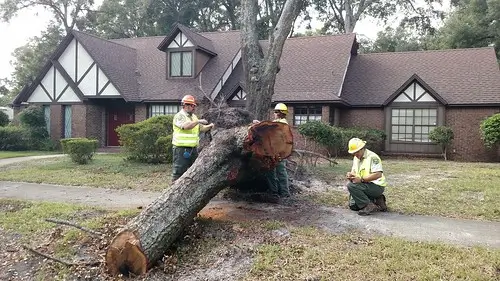In New Orleans, assessing trees is crucial for preventing storm damage by spotting weak branches and structural problems. Regular evaluations identify hazards, allowing for prompt pruning or removal to lower risks during storms. With the city’s susceptibility to hurricanes and heavy rain, this tree assessment in New Orleans from A Perfect Cut Tree protects homes, power lines, and public areas. Knowing tree health enhances safety and reduces property damage during severe weather.
Understanding Storm Risks in New Orleans
New Orleans has usual hurricanes, so tree stability is crucial to be safe. Waterlogged soil and heavy winds can weaken roots and cause trees to fall.
Favorite trees like water oaks and pecans, though thriving in the area, are particularly susceptible to storm damage due to shallow roots or brittle limbs. Severe weather conditions also worsen the already present defects like rot, cracks, or leaning trunks, which could go unnoticed if not inspected carefully.
Large trees can damage homes, vehicles, or power cables if they are knocked over, posing danger to property and life. Tree assessment can identify such weaknesses in advance, enabling repairing them before the storms, and reducing potential risks.
Why Assess Trees Before Storms?
Tree inspection before hurricane season in New Orleans is important for safety, property, and community health. The early intervention avoids trees being hit during extreme weather, reducing damage and repair costs. Inspection reveals weak tree species, underlying problems, and soil conditions, which lead to an effective prevention plan.
1. Identify Vulnerable Tree Species
Water oaks and pecans prosper in New Orleans but are vulnerable to storms because they have shallow roots and branchy structures. Older or sick trees will be more injured by high winds, especially if the trees have problems like codominant stems, included bark, or open cavities. Live oaks are less subject to storms, but Bradford pears split.
2. Detect Hidden Tree Weaknesses
Identifying hidden internal damage, such as decay or cracks, is essential. Stress signs, like early leaf drop or unusual fungal growth, can suggest structural problems. Experts use tools like seismographs to find decay and sonic tomography for a thorough tree health assessment. Documenting these results helps prioritize needed actions.
3. Evaluate Soil and Root Health
Strong roots that develop in healthy soil are what healthy trees depend on. Compacted or poorly draining soil weakens them and makes them more susceptible to being uprooted. We can aerate, mulch, and provide organic matter to the soil to help support roots. Keeping an eye on these conditions will enable our trees to weather storms.
How Tree Assessments Prevent Damage
Professional tree risk inspections are critical for minimizing storm damage, particularly in hurricane-susceptible locations such as New Orleans. By evaluating tree stability and health, property owners can determine threats early and safeguard their properties accordingly.
Professional Arborist Inspections
Annual inspections by qualified arborists are necessary to identify tree hazards like weak branches, decay, root problems, and diseases. These inspections should be done at least annually for regular monitoring. Homeowners need to inquire about weakness signs and preventive actions. Maintenance records assist in monitoring changes in tree health, resulting in improved care decisions.
Risk Assessment and Prioritization
Risk assessment explicitly identifies trees that need attention based on their condition and location, especially those near power lines, residences, or driveways, which are of higher risk. Trees are prioritized as “low,” “moderate,” or “high” and have suggested actions like pruning, bracing, or removal. Monitoring regularly updates these priorities with changing conditions so that trees do not fail unexpectedly during storms.
Tailored Mitigation Strategies
Mitigation efforts target a tree’s weaknesses. Pruning eliminates weak limbs while cabling and bracing support unstable branches. Soil aeration and deep watering improve root health. Monitoring these actions helps assess their effectiveness after storms.
Post-Storm Tree Care and Recovery
Effective planning of tree care after a storm is important for safety and long-term recovery. Using emergency tree removal services effectively can prevent hazards while preserving the health of the tree canopy and minimizing future storm damage.
Assess Damage Immediately After Storm
To keep risks low, target risky trees. Employ a checklist for determining problems such as roots exposed, leaning trunks, or broken limbs. Recording any damage facilitates planning for recovery. Collaborating with certified arborists guarantees accurate assessments of the tree’s structure and health.
Remove Hazardous Debris Safely
Safely disposing of debris saves lives and protects property. Wear gloves, and appropriate equipment, and keep away from overhead power cables as the main precautions. Avoid walking on uneven grounds and heavy lifting to avoid getting hurt. Documenting records aids compliance with local legislation, while community involvement aids in teamwork and efficiency.
Prune Broken Branches Correctly
Proper tree removal and pruning techniques encourage healthy regrowth by cutting at the right angle and location to minimize stress. Professionals should handle large branches for safety. A pruning checklist should include sterilizing tools, wearing protective gear, and cutting just outside the branch collar. Keeping a record of past actions helps monitor progress.
Monitor Tree Health and Stability
Following a storm, look at trees to observe their healing and determine whether any measure should be taken, such as seeking new growth or decay. Identifying the indication of a stressed tree versus that of a healthy tree is necessary. Seeking guidance from a qualified arborist can help with making tree care decisions.
Consider Professional Tree Removal
Severely damaged trees can be dangerous and might need removal. It’s important to consider the tree’s size, distance from buildings, and root stability. Consulting experts ensure the safe removal and provide helpful advice for future tree planting.
Enhancing Storm Resilience: The Protective Role of Tree Assessments
New Orleans storms can be rough, but good tree care dramatically lowers potential loss. Regular maintenance identifies weak branches or root problems before they cause harm, reducing risk during heavy weather. Healthy trees shield homes and add value to neighborhoods. Spending money on tree care upfront avoids surprise issues during storms and enhances overall safety and quality of life. Using certified arborists provides healthier, more durable trees. Proactive action today can prevent expensive repairs down the road. For New Orleans homeowners, having a tree evaluation scheduled is a smart move in storm preparation, keeping properties secure and trees healthy year-round.






